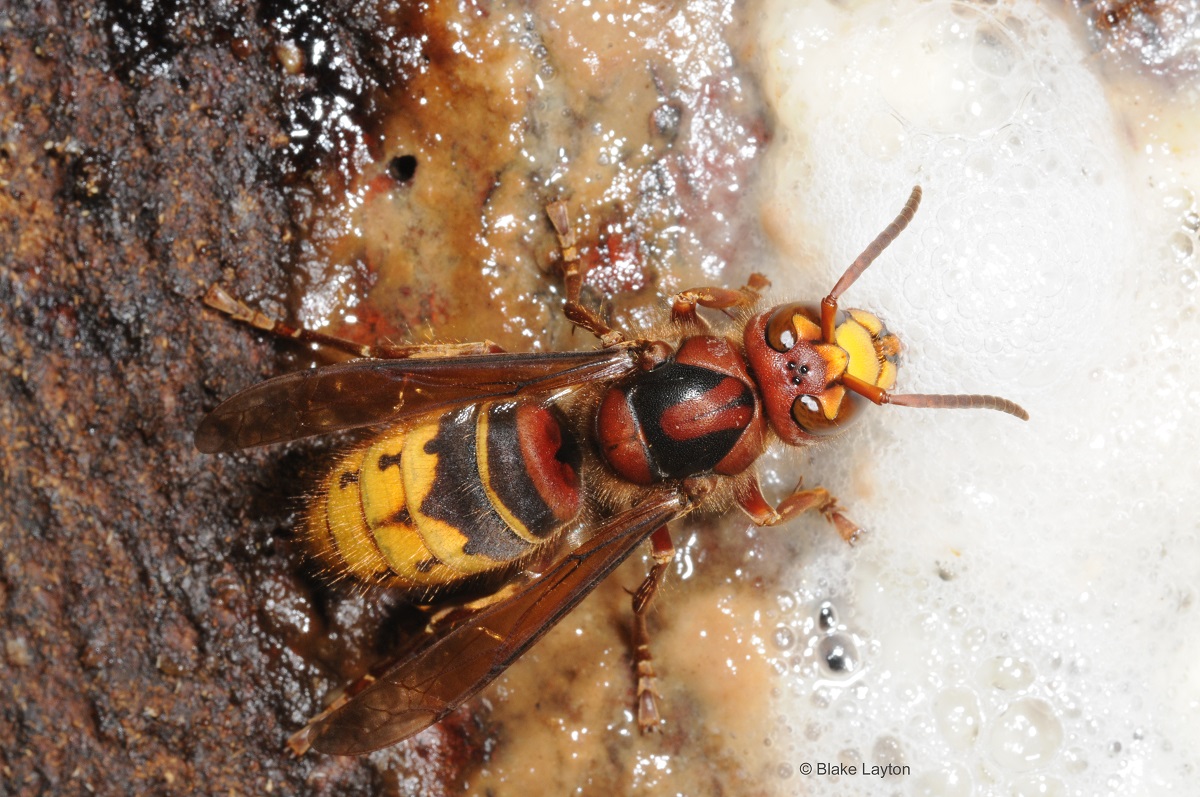European Hornet, Vol. 6, No. 11

Vespa crabro
Order: Hymenoptera
Family: Vespidae
“Some big wasps have built a nest in our deer stand and we are afraid to go near it. These things are huge! They look like hummingbirds as they fly in and out of the nest.”
European hornets are large, heavy-bodied, non-native wasps that have been in the eastern US for around 180 years. Here in Mississippi, they seem to be more common in the northern part of the state, though sting events and encounters with nests are relatively uncommon.
These are big wasps, much larger than our native bald-faced hornets, which technically are not hornets, but aerial yellowjackets. European hornet workers are about an inch long with stout, heavy bodies; the queens can be up to 1.4 inches. By late summer a nest will contain hundreds to more than a thousand hornets. Nests are usually built in dark, enclosed spaces, such as a hollow tree or voids in buildings. The nest in the deer stand was a bit atypical in that it was hanging from a cross-timber in the center of the deer stand. It was about 24 inches long and 12 to 14 inches in diameter and was completely open at the bottom. Imagine a 6-gallon bucket with the bottom cut out. The tiers of brood comb were enclosed in a paper material, much like that of bald-faced hornets, but the paper was more of a brown color, while bald-faced hornet nests are usually gray. (The background on the Bug’s Eye View header is a closeup of a bald-faced hornet nest.)
European hornets don’t collect pollen and nectar to feed their young. They prey on other insects, large insects, including honey bees. Worker hornets will hover around the entrance to a hive to catch bees from the air as they come or go and then use their mandibles to behead the bee and remove the wings and legs before carrying it to their nest. While individual honey bees are easy pickings, honey bees work together to defend their hive and are sometimes able to kill attacking hornets using a defensive behavior called balling. Balling occurs when a group of up to 100+ worker bees grasp an attacking hornet, ball around it, and raise the internal temperature of the ball to a high enough temperature to kill the hornet (around 111o F) by vibrating their bodies. Shake and bake! Beekeepers sometimes find dead hornets lying in front of a hive, as evidence of a successful defense. Overall, European hornets are more of a minor nuisance than a major threat to beekeepers.
European hornets exhibit two other unusual behaviors. Unlike most other stinging insects, European hornets can and will fly at night, and they are attracted to light. Sometimes people will notice these large insects banging into their windows at night, as if they are trying to get in. Also, in late summer and fall European hornets sometimes damage trees and shrubs by chewing away the outer bark to feed on the sweet inner bark. These debarked areas can be quite large, girdling whole limbs and sometimes causing significant damage to main trunks.
Can these big wasps sting? Of course, and the sting is said to be quite painful. The venom is reported to be a bit less toxic than honey bee venom, but there’s more of it, and one report from Europe indicates that people are more likely to develop anaphylactic shock in response to European hornet venom.
How do European hornets compare to the Asian giant hornets you may have heard about recently? Asian giant hornets, Vespa mandarinia, belong to the same genus and are generally similar in appearance and biology, but they are about twice as big and the honey bees we have in the US are not able to kill these giants by balling. Fortunately, Asian giant hornets do not occur here, though they recently have been detected in the state of Washington.
Blake Layton, Extension Entomology Specialist, Mississippi State University Extension Service.
The information given here is for educational purposes only. Always read and follow current label directions. Specific commercial products are mentioned as examples only and reference to specific products or trade names is made with the understanding that no discrimination is intended to other products that may also be suitable and appropriately labeled.
Mississippi State University is an equal opportunity institution.

